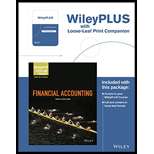
(a)
Accounts receivable:
Accounts receivable refers to the amounts to be received with interest, within a short period from customers upon the sale of goods, and services on account. In other words, accounts receivable are amounts customers owe to the business. Accounts receivable is an asset of a business.
Bad debt expense is an expense account. Amount of loss incurred from extending credit to the customers are recorded as bad debt expense. In other words, estimated uncollectible accounts receivable are known as bad debt expense.
Aging of receivables method:
A method of determining the estimated uncollectible receivables, based on the age of individual accounts receivable, is known as aging of receivables method.
The amount of the (1) accounts receivable outstanding and (2) estimated uncollectible amount of Company RLF using the accounts receivable aging schedule.
(b)
To compute: The amount to be adjusted to the allowance for doubtful accounts as per the age analysis, and to prepare
(c) (1)
To identify: The steps that RLF Company must consider to improve the accounts receivable situation.
(2)
To evaluate: Each step identified to improve the RLF Company’s accounts receivable situation in terms of the risks, and costs involved.
Want to see the full answer?
Check out a sample textbook solution
Chapter 8 Solutions
Financial Accounting, 10e WileyPLUS Registration Card + Loose-leaf Print Companion
- You have been asked to test the effectiveness of Ingo Corporation’s control of manually approving all purchases over $25,000. During the year, Ingo Corporation has made 1,000,000 purchases, of which 3,000 were over $25,000. Jian Zhang, CPA, your supervisor, asked you to use a tolerable deviation rate of 4 percent (although she expects the rate to be only approximately 0.50 percent) and a 5 percent risk of assessing control risk too low. Use the following to determine the planned assessed level of control risk and the assessed level of control risk. (Planned) Assessed Level of Control Risk Tolerable Deviation Rate Low 2−7% Moderate 6−12% Slightly below the maximum 11−20% Maximum Over 20% Expected Population Deviation Rate (as Percentages) Tolerable Deviation Rate 2% 3% 4% 5% 6% 7% 8% 9% 10% 15% 20% 0.00% 149(0) 99(0) 74(0) 59(0) 49(0) 42(0) 36(0) 32(0) 29(0) 19(0) 14(0) 0.25 236(1) 157(1) 117(1) 93(1) 78(1) 66(1) 58(1) 51(1) 46(1) 30(1) 22(1) 0.50 * 157(1)…arrow_forwardWhat is taxable income? Financial accountingarrow_forwardI need the correct answer to this financial accounting problem using the standard accounting approach.arrow_forward
- On September 1, Rivertown Inc. paid $9,000 for a six- month insurance policy that begins on September 1. What amount would appear in the Prepaid Insurance account on an adjusted trial balance dated December 31? A. $3,000 B. $1,500 C. $4,500 D. $0arrow_forwardPlease provide the accurate answer to this general accounting problem using appropriate methods.arrow_forwardsolve this question step by step and correct approach.arrow_forward
- Need help in this accounting questions please.arrow_forwardCan you help me solve this financial accounting question using the correct financial procedures?arrow_forwardNew revenue recognition standard brings in significant changes the way a company should determine the amount of revenue to report on its financial statements. As an auditor what challenges or issues are in understanding the five step revenue recognition model as implemented by a client and how can they assess the risk of material misstatement in revenue?arrow_forward

 AccountingAccountingISBN:9781337272094Author:WARREN, Carl S., Reeve, James M., Duchac, Jonathan E.Publisher:Cengage Learning,
AccountingAccountingISBN:9781337272094Author:WARREN, Carl S., Reeve, James M., Duchac, Jonathan E.Publisher:Cengage Learning, Accounting Information SystemsAccountingISBN:9781337619202Author:Hall, James A.Publisher:Cengage Learning,
Accounting Information SystemsAccountingISBN:9781337619202Author:Hall, James A.Publisher:Cengage Learning, Horngren's Cost Accounting: A Managerial Emphasis...AccountingISBN:9780134475585Author:Srikant M. Datar, Madhav V. RajanPublisher:PEARSON
Horngren's Cost Accounting: A Managerial Emphasis...AccountingISBN:9780134475585Author:Srikant M. Datar, Madhav V. RajanPublisher:PEARSON Intermediate AccountingAccountingISBN:9781259722660Author:J. David Spiceland, Mark W. Nelson, Wayne M ThomasPublisher:McGraw-Hill Education
Intermediate AccountingAccountingISBN:9781259722660Author:J. David Spiceland, Mark W. Nelson, Wayne M ThomasPublisher:McGraw-Hill Education Financial and Managerial AccountingAccountingISBN:9781259726705Author:John J Wild, Ken W. Shaw, Barbara Chiappetta Fundamental Accounting PrinciplesPublisher:McGraw-Hill Education
Financial and Managerial AccountingAccountingISBN:9781259726705Author:John J Wild, Ken W. Shaw, Barbara Chiappetta Fundamental Accounting PrinciplesPublisher:McGraw-Hill Education





